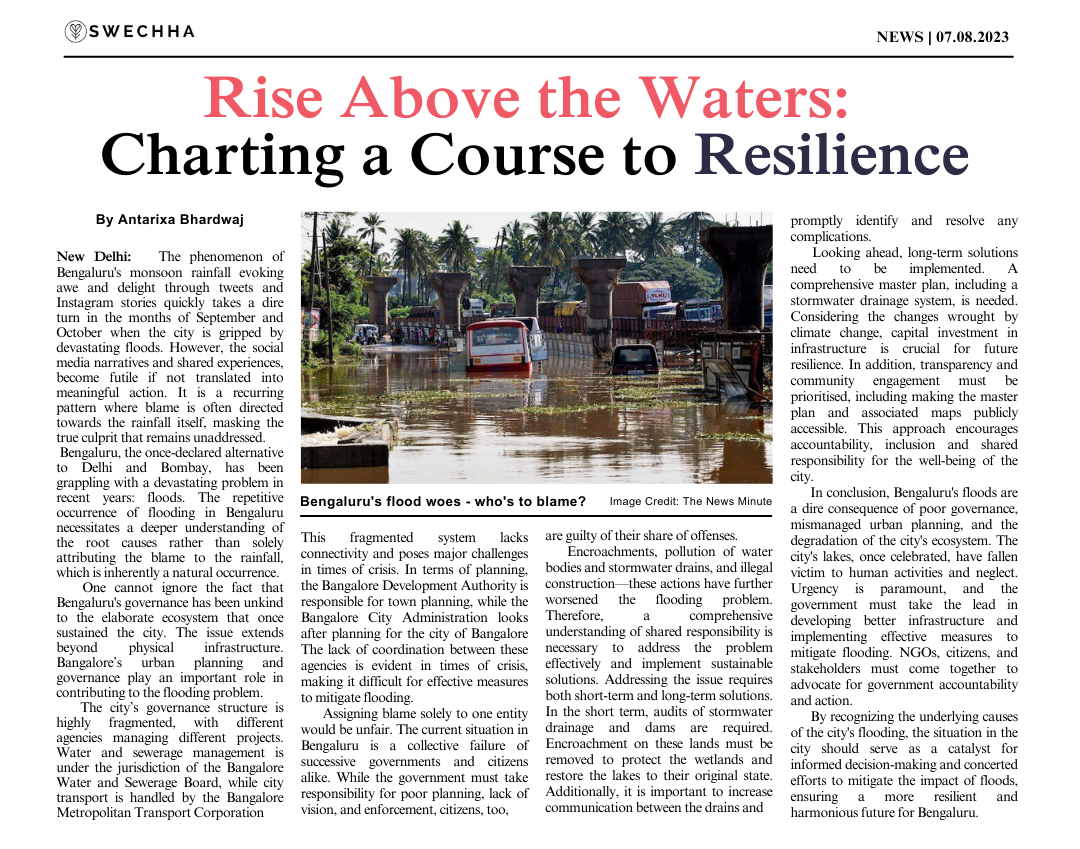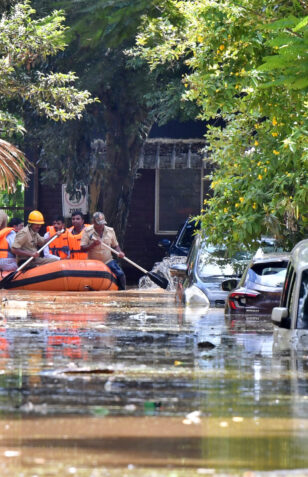RISE ABOVE THE WATERS: CHARTING A COURSE TO RESILIENCE
- by Antarixa Bhardwaj

The phenomenon of Bengaluru's monsoon rainfall evoking awe and delight through tweets and Instagram stories quickly takes a dire turn in the months of September and October when the city is gripped by devastating floods. However, the social media narratives and shared experiences, become futile if not translated into meaningful action. It is a recurring pattern where blame is often directed towards the rainfall itself, masking the true culprit that remains unaddressed.
Bengaluru, the once-declared alternative to Delhi and Bombay, has been grappling with a devastating problem in recent years: floods. The repetitive occurrence of flooding in Bengaluru necessitates a deeper understanding of the root causes rather than solely attributing the blame to the rainfall, which is inherently a natural occurrence.
One cannot ignore the fact that Bengaluru's governance has been unkind to the elaborate ecosystem that once sustained the city. The issue extends beyond physical infrastructure. Bangalore’s urban planning and governance play an important role in contributing to the flooding problem. The city’s governance structure is highly fragmented, with different agencies managing different projects. Water and sewerage management is under the jurisdiction of the Bangalore Water and Sewerage Board, while city transport is handled by the Bangalore Metropolitan Transport Corporation This fragmented system lacks connectivity and poses major challenges in times of crisis. In terms of planning, the Bangalore Development Authority is responsible for town planning, while the Bangalore City Administration looks after planning for the city of Bangalore. The lack of coordination between these agencies is evident in times of crisis, making it difficult for effective measures to mitigate flooding.
Assigning blame solely to one entity would be unfair. The current situation in Bengaluru is a collective failure of successive governments and citizens alike. While the government must take responsibility for poor planning, lack of vision, and enforcement, citizens too are guilty of their share of offenses. Encroachments, pollution of water bodies and stormwater drains, and illegal construction—these actions have further worsened the flooding problem. Therefore, a comprehensive understanding of shared responsibility is necessary to address the problem effectively and implement sustainable solutions. Addressing the issue requires both short-term and long-term solutions. In the short term, audits of stormwater drainage and dams are required. Encroachment on these lands must be removed to protect the wetlands and restore the lakes to their original state. Additionally, it is important to increase communication between the drains and promptly identify and resolve any complications.
Looking ahead, long-term solutions need to be implemented. A comprehensive master plan, including a stormwater drainage system, is needed. Considering the changes wrought by climate change, capital investment in infrastructure is crucial for future resilience. In addition, transparency and community engagement must be prioritised, including making the master plan and associated maps publicly accessible. This approach encourages accountability, inclusion and shared responsibility for the well-being of the city.

Image source - Reuters

Image source - Down to Earth
Highlights
- Degradation of Bengaluru's Ecosystem: Bengaluru's once vibrant ecosystem, supported by its network of lakes, has suffered severe degradation due to filling up of lakes, encroachments, and concretization. This disruption has contributed to the flooding problem plaguing the city.
- Fragmented Governance System: The city's fragmented governance system, with multiple agencies responsible for different services, hampers coordination during crises. This lack of coordination exacerbates the flooding issue and poses significant challenges for effective management.
- Shared Responsibility: The blame for Bengaluru's water woes cannot be placed solely on the government or citizens. Both successive governments and citizens must share the responsibility for the city's flooding problems. Poor planning, lack of vision, encroachments, and illegal constructions are among the factors contributing to the crisis.
- Bangalore 88 per cent decline in total vegetation cover and a 79 percent decline in water bodies (wetlands) between 1973 to 2017 on account of increased concretisation of urban areas owing to cascading urbanisation. Photo from Frequent Floods in Bangalore: Causes and Remedial Measures report.
To sum up, Bengaluru's floods are a dire consequence of poor governance, mismanaged urban planning, and the degradation of the city's ecosystem. The city's lakes, once celebrated, have fallen victim to human activities and neglect.
Urgency is paramount, and the government must take the lead in developing better infrastructure and implementing effective measures to mitigate flooding. NGOs, citizens, and stakeholders must come together to advocate for government accountability and action. By recognizing the underlying causes of the city's flooding, the situation in the city should serve as a catalyst for informed decision-making and concerted efforts to mitigate the impact of floods, ensuring a more resilient and harmonious future for Bengaluru.

